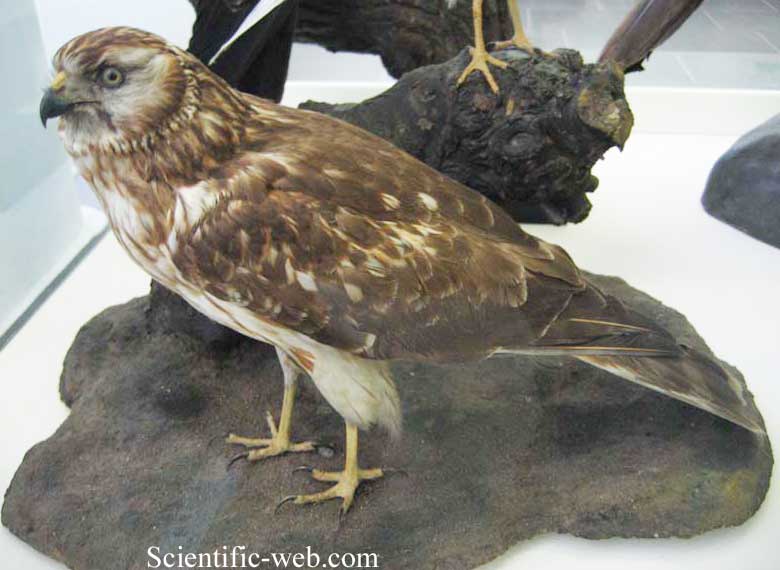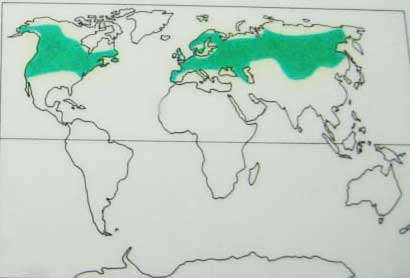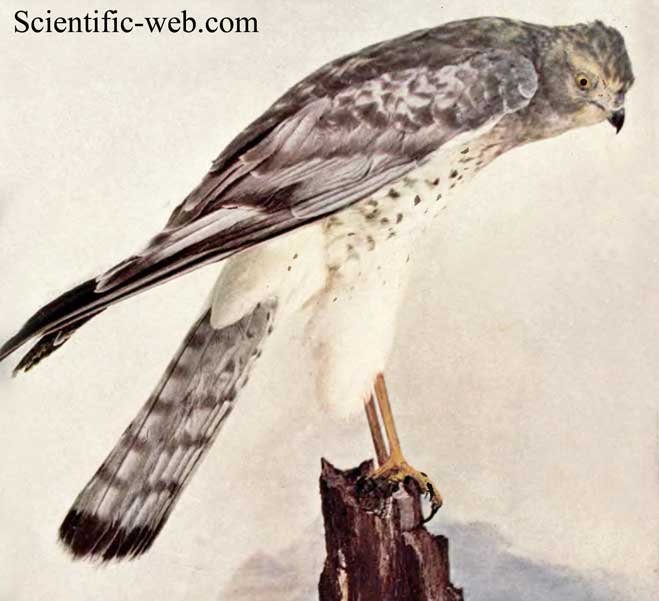Circus cyaneus, Photo: Michael Lahanas Cladus: Eukaryota
Circus cyaneus Name Circus cyaneus Linnaeus, 1766 References * Systema Naturae ed.12 p.126 Vernacular names The Northern Harrier (Circus cyaneus) or Hen Harrier (in North America) is a bird of prey. It breeds throughout the northern parts of the northern hemisphere in Canada and the northernmost USA, and in northern Eurasia. This species is polytypic, with two subspecies. Marsh Hawk is a historical name for the American form.[2] It migrates to more southerly areas in winter. Eurasian birds move to southern Europe and southern temperate Asia, and American breeders to the southernmost USA, Mexico, and Central America. In the mildest regions, such as France, Great Britain, and the southern US, Northern Harriers may be present all year, but the higher ground is largely deserted in winter. Description The Northern Harrier is 45–55 cm long with a 97–118 cm wingspan.[3] It resembles other harriers in having distinct male and female plumages. The sexes also differ in weight, with males weighing an average of 350 g and females an average of 530 g.[2] The male of the nominate race, C. c. cyaneus (Linnaeus, 1766), breeds in Europe and Asia, is mainly grey above and white below except for the upper breast, which is grey like the upperparts, and the rump, which is white; the wings are grey with black wingtips. The female is brown above with white upper tail coverts, hence females, and the similar juveniles, are often called "ringtails". Their underparts are buff streaked with brown.[2] The female gives a whistled piih-eh when receiving food from the male, and her alarm call is chit-it-it-it-it-et-it. The male calls chek-chek-chek, with a more bouncing chuk-uk-uk-uk during his display flight[3] Northern Harrier C. c. hudsonius (Linnaeus, 1766), the Northern Harrier, breeds in North America and is sometimes considered a distinct species C. hudsonius.[4] The male's plumage is darker grey than that of C. c. cyaneus and the female is also darker and more rufous in colour.[2] Behaviour This medium-sized raptor breeds on moorland, bogs and (in Europe) farmland. The nest is on the ground. Four to six whitish eggs are laid.[2] In winter, the Northern Harrier is a bird of open country, and will then roost communally, often with Merlins and Marsh Harriers. There is now an accepted record of transatlantic vagrancy by the American subspecies, with a juvenile being recorded in Scilly, Great Britain from October 1982 to June 1983.[5] This is a typical harrier, with long wings held in a shallow V in its low, contour-hugging, flight. Hen Harriers hunt small mammals and birds, surprising them as they drift low over fields and moors.[2] This harrier tend to be a very vocal bird while it glides over its hunting ground. Status This species has a large range, with an estimated global extent 1–20 million km², and a population estimated at 1.3 million individuals. There is evidence of a population decline, but the species is not believed to approach the thresholds for the population decline criterion of the IUCN Red List (i.e., declining more than 30% in ten years or three generations). It is therefore classified as "least concern".[1] Problems in the United Kingdom In the UK, the Northern Harrier suffers illegal persecution by gamekeepers and their employers on shooting estates, particularly those managed for Red Grouse shooting, resulting in local and regional extinction in many areas, particularly in England where only 20 pairs survive despite abundant suitable habitat capable of holding several hundred pairs.[6][7][8] Because of this they are now very rare in many parts of the UK, and under threat in many more areas.[9][10][11] This problem received a high profile in October 2007 when police investigating the killing of two Northern Harriers on the Queen's estate at Sandringham in Norfolk interviewed Prince Harry and a friend during their investigation.[12][13] No charges were brought as police were unable to obtain sufficient evidence to prosecute.[7][14] Since the assumed threat to Red Grouse is the main reason for the persecution of this species in the UK, a project funded by Scottish Natural Heritage, the Game & Wildlife Conservation Trust, the RSPB and Natural England was launched at Langholm Moor in Scotland from 2007. The Langholm Moor Demonstration Project (LMDP), a 10-year investigation, costing £3 million, is intended to see whether grouse and raptors can live side-by-side harmoniously. A similar project, the Joint Raptor Study (also referred to as the 'JRS' or 'the Langholm Study') was run on Langholm from 1992 to 1997. The study made many findings and a host of peer reviewed papers were published on the work, in addition to the final report. Among the most often quoted findings were that long term declines in red grouse populations were "extremely unlikely" to be due to raptor predation and were attributed to habitat degradation/loss, and that raptor predation was the most likely explanation for the failure of grouse stocks to recover at Langholm once the population had fallen to a low level.[15] The project ended in 1997, although a follow up supplementary feeding trial was run by the same team in 1998 and 1999. Grouse shooting on the moor was abandoned for the 1998 season onwards.[16][17] Forestry and Northern Harriers The Northern Harrier is a bird of open habitats such as heather moorland and extensive agriculture. However, much of its range, particularly in Ireland and parts of western Britain, has been (and continues to be) afforested, predominantly with non-native conifers such as Sitka Spruce (Picea sitchensis) from North America (Barton et al. 2006,[18] Fielding et al. 2009[19]). Northern Harriers nest and forage in commercial forestry when it is young, before the canopy closes (typically at between 9–12 and years old), but do not make much use of thicket and subsequent growth stages (Madders 2000,[20] O'Donoghue 2004[21]), which typically comprise between two thirds and three quarters of the commercial growth cycle. Where forests replace habitats that were used by Northern Harriers they will therefore tend to reduce overall habitat availability (O'Flynn, 1983[22]). However, where afforestation takes place in areas that were previously underutilised by Northern Harriers, it may increase the value of such areas to this species in the long-term (Wilson et al. 2009,[23] Haworth & Fielding 2009[24]). Areas dominated by forestry may remain suitable to Northern Harriers provided that a mosaic of age classes is maintained within the forest, such that areas of young, pre-thicket forest are always available. References ^ a b BirdLife International (2004). Circus cyaneus. 2006. IUCN Red List of Threatened Species. IUCN 2006. www.iucnredlist.org. Retrieved on 11 May 2006. Database entry includes justification for why this species is of least concern Source: Wikipedia, Wikispecies: All text is available under the terms of the GNU Free Documentation License |
|



